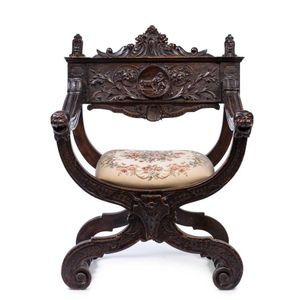Victorian Walnut Griffin Occasional Table
You must be a subscriber, and be logged in to view price and dealer details.
Subscribe Now to view actual auction price for this item
When you subscribe, you have the option of setting the currency in which to display prices to $Au, $US, $NZ or Stg.
- Tier - One or more under-shelves of a table or cabinet.
- Griffin / Griffon / Gryphon - A griffin, also known as a griffon or gryphon, is a mythical creature with the body of a lion and the head of an eagle. It is typically depicted as a powerful and majestic beast, with the body and legs of a lion and the head, wings, and talons of an eagle. The griffin is widely recognized as a symbol of strength, courage, and guardianship, and has been used in a variety of cultures throughout history.
In ancient mythology, the griffin was often associated with the gods and was considered a symbol of divine power. In ancient Greece, for example, the griffin was associated with the sun god Helios, while in ancient Egypt, it was associated with the goddess Hathor. In medieval European heraldry, the griffin was used as a symbol of strength, valour, and protection, and was often featured on the coats of arms of noble families. - Incised - A record of a name, date or inscription, or a decoration scratched into a surface, usually of a glass or ceramic item with a blunt instrument to make a coarse indentation. Compare with engraving where the surface is cut with a sharp instrument such as a metal needle or rotating tool to achieve a fine indentation.
- Victorian Period - The Victorian period of furniture and decorative arts design covers the reign of Queen Victoria from 1837 to 1901. There was not one dominant style of furniture in the Victorian period. Designers used and modified many historical styles such as Gothic, Tudor, Elizabethan, English Rococo, Neoclassical and others, although use of some styles, such as English Rococo and Gothic tended to dominate the furniture manufacture of the period.
The Victorian period was preceded by the Regency and William IV periods, and followed by the Edwardian period, named for Edward VII (1841 ? 1910) who was King of the United Kingdom and the British Dominions and Emperor of India for the brief period from 1901 until his death in 1910. - Claw Feet - Carved or cast in the shape of a lion's claw or the talons of other more fabulous beasts. They may be found on chair and table legs, supporting platform bases, and cabinets in the Classical Revival manner. Claw feet are not uncommon on Australian furniture made throughout the 1850s and 1860s, though, as with all forms of carving, the deeper and richer the claws are carved, the earlier the piece is likely to be.
This item has been included into following indexes:
Visually similar items

A Chinese carved elaborate dragon and phoenix armchair mid 20th century, height 86 cm

A carved walnut Renaissance revival Savonarola chair, late 19th century, with later tapestry covered seat

Pair of pink coloured hardstone elephants with trunks held aloft, on fitted stands. Height 10 cm

A finely cast bronze sculpture of two tigers, Japanese, Meiji period (1868-1912), signed, on carved wooden stand, approx. 28 cm high, 80 cm long
